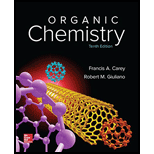
Concept explainers
Interpretation:
The classification of the formation of industrial preparation of methyl bromide from methanol by reaction with hydrogen bromide is to be done. The stepwise mechanism is to be written.
Concept introduction:
The reaction of methyl and primary alcohols with hydrogen halide mostly proceeds through
The reaction of tertiary alcohol with hydrogen halide proceeds through
The
The
Formation of carbocation is the rate determining step in
The nucleophile (halide ion) attacks on the electrophilic carbon from opposite side of hydroxyl group (i.e. backside attack) in
The position of leaving group in reactant and that of nucleophile in the product are same in case of
Want to see the full answer?
Check out a sample textbook solution
Chapter 5 Solutions
Solutions Manual for Organic Chemistry
- The following sequence of steps converts (R)-2-octanol to (S)-2-octanol. Propose structural formulas for intermediates A and B, specify the configuration of each, and account for the inversion of configuration in this sequence.arrow_forwardThe tosylate of a primary alcohol normally undergoes an SN2 reaction with hydroxide ion to give a primary alcohol. Reaction of this tosylate, however, gives a compound of molecular formula C7H12O. Propose a structural formula for this compound and a mechanism for its formation.arrow_forwardTerpin, prepared commercially by the acid-catalyzed hydration of limonene, is used medicinally as an expectorant for coughs. (a) Propose a structural formula for terpin and a mechanism for its formation. (b) How many cis, trans isomers are possible for the structural formula you propose?arrow_forward
- Enamines normally react with methyl iodide to give two products: one arising from alkylation at nitrogen and the second arising from alkylation at carbon. For example, Heating the mixture of C-alkylation and N-alkylation products gives only the product from C-alkylation. Propose a mechanism for this isomerization.arrow_forwardUnder milder temperatures than what is needed for dehydration, strong acids catalyze the self-condensation of 1-propyl alcohol to give di-n-propyl ether. The mechanism differs from that of today's reaction in that the protonated alcohol undergoes an Sn2 rather than an Sn1 reaction. Write the mechanism for the acid catalyzed condensation of ethyl alcohol to give diethyl ether. Make sure the mechanism includes protonation, Sn2, and deprotonation.arrow_forward3b)Give the mechanisms for the following transformations:arrow_forward
- H8. Give mechanisms for BOTH of the following transformations.arrow_forwardDraw the reaction mechanism of conversion of compound 4a to 4b. Indicate what type of reaction mechanism. Write conditions and reagents used if there are any. Provide brief background in every step of the reaction mechanism.arrow_forwardWhen (1-bromoethyl)cyclohexane is heated in methanol for an extended period of time, five products result: two ethers and three alkenes. Predict the products of this reaction, and propose mechanisms for their formation. Predict which of the three alkenes is the major elimination productarrow_forward
- 8a)Provide mechanisms for the following reactions:arrow_forward1. Methylene cyclohexane, on treatment with strong acid, isomerises to yield methyl cyclohexene. Propose a mechanism by which the reaction might occur.arrow_forwardNeopentyl alcohol, (CH3)3CCH2OH, reacts with concentrated HBr to give 2-bromo2-methylbutane, a rearranged product. Propose a mechanism for the formation of thisproduct.arrow_forward

 Organic ChemistryChemistryISBN:9781305580350Author:William H. Brown, Brent L. Iverson, Eric Anslyn, Christopher S. FootePublisher:Cengage Learning
Organic ChemistryChemistryISBN:9781305580350Author:William H. Brown, Brent L. Iverson, Eric Anslyn, Christopher S. FootePublisher:Cengage Learning

